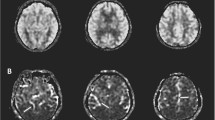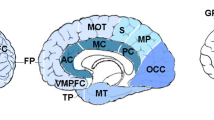Abstract
The objective of the study was to evaluate the prognostic value of regional cerebral blood flow (CBF) measured by arterial spin labeled (ASL) perfusion MRI in patients with semantic variant primary progressive aphasia (svPPA). We acquired pseudo-continuous ASL (pCASL) MRI and whole-brain T1-weighted structural MRI in svPPA patients (N = 13) with cerebrospinal fluid biomarkers consistent with frontotemporal lobar degeneration pathology. Follow-up T1-weighted MRI was available in a subset of patients (N = 8). We performed whole-brain comparisons of partial volume-corrected CBF and cortical thickness between svPPA and controls, and compared baseline and follow-up cortical thickness in regions of significant hypoperfusion and hyperperfusion. Patients with svPPA showed partial volume-corrected hypoperfusion relative to controls in left temporal lobe and insula. svPPA patients also had typical cortical thinning in anterior temporal, insula, and inferior frontal regions at baseline. Volume-corrected hypoperfusion was seen in areas of significant cortical thinning such as the left temporal lobe and insula. Additional regions of hypoperfusion corresponded to areas without cortical thinning. We also observed regions of hyperperfusion, some associated with cortical thinning and others without cortical thinning, including right superior temporal, inferior parietal, and orbitofrontal cortices. Regions of hypoperfusion and hyperperfusion near cortical thinning at baseline had significant longitudinal thinning between baseline and follow-up scans, but perfusion changes in distant areas did not show progressive thinning. Our findings suggest ASL MRI may be sensitive to functional changes not readily apparent in structural MRI, and specific changes in perfusion may be prognostic markers of disease progression in a manner consistent with cell-to-cell spreading pathology.



Similar content being viewed by others
References
Hodges JR, Patterson K, Oxbury S, Funnell E (1992) Semantic dementia: progressive fluent aphasia with temporal lobe atrophy. Brain 115:1783–1806
Grossman M, McMillan C, Moore P et al (2004) What’s in a name: voxel-based morphometric analyses of MRI and naming difficulty in Alzheimer’s disease, frontotemporal dementia and corticobasal degeneration. Brain 127:628–649. doi:10.1093/brain/awh075
Whitwell JL, Avula R, Senjem ML et al (2010) Gray and white matter water diffusion in the syndromic variants of frontotemporal dementia. Neurology 74:1279–1287. doi:10.1212/WNL.0b013e3181d9edde
Drzezga A, Grimmer T, Henriksen G et al (2008) Imaging of amyloid plaques and cerebral glucose metabolism in semantic dementia and Alzheimer’s disease. Neuroimage 39:619–633. doi:10.1016/j.neuroimage.2007.09.020
Diehl J, Grimmer T, Drzezga A et al (2004) Cerebral metabolic patterns at early stages of frontotemporal dementia and semantic dementia. A PET study. Neurobiol Aging 25:1051–1056. doi:10.1016/j.neurobiolaging.2003.10.007
Desgranges B, Matuszewski V, Piolino P et al (2007) Anatomical and functional alterations in semantic dementia: a voxel-based MRI and PET study. Neurobiol Aging 28:1904–1913. doi:10.1016/j.neurobiolaging.2006.08.006
Nestor PJ, Fryer TD, Hodges JR (2006) Declarative memory impairments in Alzheimer’s disease and semantic dementia. Neuroimage 30:1010–1020. doi:10.1016/j.neuroimage.2005.10.008
Guo CC, Gorno-Tempini ML, Gesierich B et al (2013) Anterior temporal lobe degeneration produces widespread network-driven dysfunction. Brain 136:2979–2991. doi:10.1093/brain/awt222
Rohrer JD, McNaught E, Foster J et al (2008) Tracking progression in frontotemporal lobar degeneration: serial MRI in semantic dementia. Neurology 71:1445–1451. doi:10.1212/01.wnl.0000327889.13734.cd
Corouge I, Esquevin A, Lejeune F, et al. (2012) Arterial spin labeling at 3T in semantic dementia: perfusion abnormalities detection and comparison with FDG-PET. Med Image Comput Comput Interv 2012 Workshop Nov Biomark Alzheimer’s Dis Relat Disord 32–40
Detre JA, Rao H, Wang DJJ et al (2012) Applications of arterial spin labeled MRI in the brain. J Magn Reson Imaging 35:1026–1037. doi:10.1002/jmri.23581
Du AT, Jahng GH, Hayasaka S et al (2006) Hypoperfusion in frontotemporal dementia and Alzheimer disease by arterial spin labeling MRI. Neurology 67:1215–1220. doi:10.1212/01.wnl.0000238163.71349.78
Alsop DC, Dai W, Grossman M, Detre JA (2010) Arterial spin labeling blood flow MRI: its role in the early characterization of Alzheimer’s disease. J Alzheimer’s Dis 20:871–880. doi:10.3233/JAD-2010-091699
Hu WT, Wang Z, Lee VM-Y et al (2010) Distinct cerebral perfusion patterns in FTLD and AD. Neurology 75:881–888. doi:10.1212/WNL.0b013e3181f11e35
Kandel BM, Wang DJJ, Detre JA et al (2015) Decomposing cerebral blood flow MRI into functional and structural components: a non-local approach based on prediction. Neuroimage 105:156–170. doi:10.1016/j.neuroimage.2014.10.052
Nestor PJ, Graham NL, Fryer TD et al (2003) Progressive non-fluent aphasia is associated with hypometabolism centred on the left anterior insula. Brain 126:2406–2418. doi:10.1093/brain/awg240
Baron JC, Bousser MG, Comar D, Castaigne P (1981) “Crossed cerebellar diaschisis” in human supratentorial brain infarction. Trans Am Neurol Assoc 105:459–461
Zhou J, Gennatas ED, Kramer JH et al (2012) Predicting regional neurodegeneration from the healthy brain functional connectome. Neuron 73:1216–1227. doi:10.1016/j.neuron.2012.03.004
Jucker M, Walker LC (2013) Self-propagation of pathogenic protein aggregates in neurodegenerative diseases. Nature 501:45–51
Crossley NA, Mechelli A, Scott J et al (2014) The hubs of the human connectome are generally implicated in the anatomy of brain disorders. Brain 137:2382–2395. doi:10.1093/brain/awu132
Buckner RL, Sepulcre J, Talukdar T et al (2009) Cortical hubs revealed by intrinsic functional connectivity: mapping, assessment of stability, and relation to Alzheimer’s disease. J Neurosci 29:1860–1873. doi:10.1523/JNEUROSCI.5062-08.2009
Wu W-C, Fernández-Seara M, Detre JA et al (2007) A theoretical and experimental investigation of the tagging efficiency of pseudocontinuous arterial spin labeling. Magn Reson Med 58:1020–1027. doi:10.1002/mrm.21403
Gorno-Tempini ML, Hillis AE, Weintraub S et al (2011) Classification of primary progressive aphasia and its variants. Neurology 76:1006–1014. doi:10.1212/WNL.0b013e31821103e6
Irwin DJ, McMillan CT, Toledo JB et al (2012) Comparison of cerebrospinal fluid levels of tau and Aβ 1-42 in Alzheimer disease and frontotemporal degeneration using 2 analytical platforms. Arch Neurol 69:1018–1025. doi:10.1001/archneurol.2012.26
Tustison NJ, Cook PA, Klein A et al (2014) Large-scale evaluation of ANTs and FreeSurfer cortical thickness measurements. Neuroimage 99:166–179. doi:10.1016/j.neuroimage.2014.05.044
Klein A, Ghosh SS, Avants B et al (2010) Evaluation of volume-based and surface-based brain image registration methods. Neuroimage 51:214–220. doi:10.1016/j.neuroimage.2010.01.091
Avants BB, Epstein CL, Grossman M, Gee JC (2008) Symmetric diffeomorphic image registration with cross-correlation: evaluating automated labeling of elderly and neurodegenerative brain. Med Image Anal 12:26–41. doi:10.1016/j.media.2007.06.004
Avants BB, Tustison N, Song G, Cook P (2011) A reproducible evaluation of ANTs similarity metric performance in brain image registration. Neuroimage 54:2033–2044. doi:10.1016/j.neuroimage.2010.09.025
Das SRSSR, Avants BB, Grossman M, Gee JCJ (2009) Registration based cortical thickness measurement. Neuroimage 45:867–879. doi:10.1016/j.neuroimage.2008.12.016.Registration
Satterthwaite TD, Shinohara RT, Wolf DH et al (2014) Impact of puberty on the evolution of cerebral perfusion during adolescence. Proc Natl Acad Sci USA 111:8643–8648. doi:10.1073/pnas.1400178111
Avants BB, Lakshmikanth SK, Duda JT et al (2012) Robust cerebral blood flow reconstruction from perfusion imaging with an open-source, multi-platform toolkit. Proc Perfus MRI Stand Beyond CBF Everyday Clin Appl Int Soc Magn Reson Med Sci Workshop 21:21
Johnson NA, Jahng G-H, Weiner MW et al (2005) Pattern of cerebral hypoperfusion in Alzheimer disease and mild cognitive impairment measured with arterial spin-labeling MR imaging: initial experience. Radiology 234:851–859. doi:10.1148/radiol.2343040197
Winkler AM, Ridgway GR, Webster MA et al (2014) Permutation inference for the general linear model. Neuroimage 92:381–397. doi:10.1016/j.neuroimage.2014.01.060
Newhart M, Ken L, Kleinman JT et al (2007) Neural networks essential for naming and word comprehension. Cogn Behav Neurol 20:25–30. doi:10.1097/WNN.0b013e31802dc4a7
Friederici A, Rueschemeyer S (2003) The role of left inferior frontal and superior temporal cortex in sentence comprehension: localizing syntactic and semantic processes. Cereb Cortex 13:170–177
Bolling DZ, Pitskel NB, Deen B et al (2011) Dissociable brain mechanisms for processing social exclusion and rule violation. Neuroimage 54:2462–2471. doi:10.1016/j.neuroimage.2010.10.049.Dissociable
Furl N, Averbeck BB (2011) Parietal cortex and insula relate to evidence seeking relevant to reward-related decisions. J Neurosci 31:17572–17582. doi:10.1523/JNEUROSCI.4236-11.2011
Kim E-J, Sidhu M, Gaus SE et al (2012) Selective frontoinsular von economo neuron and fork cell loss in early behavioral variant frontotemporal dementia. Cereb Cortex 22:251–259. doi:10.1093/cercor/bhr004
Rosen HJ, Gorno-Tempini ML, Goldman WP et al (2002) Patterns of brain atrophy in frontotemporal dementia and semantic dementia. Neurology 58:198–208. doi:10.1212/WNL.58.2.198
Dukart J, Mueller K, Horstmann A et al (2010) Differential effects of global and cerebellar normalization on detection and differentiation of dementia in FDG-PET studies. Neuroimage 49:1490–1495. doi:10.1016/j.neuroimage.2009.09.017
Edwards-Lee T, Miller BL, Benson DF et al (1997) The temporal variant of frontotemporal dementia. Brain 120:1027–1040
Andoh J, Martinot J-L (2008) Interhemispheric compensation: a hypothesis of TMS-induced effects on language-related areas. Eur psychiatry 23:281–288. doi:10.1016/j.eurpsy.2007.10.012
Halpern CH, Glosser G, Clark R et al (2004) Dissociation of numbers and objects in corticobasal degeneration and semantic dementia. Neurology 62:1163–1169
Acknowledgments
This work was supported in part by the National Institutes of Health: AG017586, AG043503, AG015116, NS044266, AG032953, the Wyncote Foundation, and the Arking Family Foundation. Open-source ANTs software, available at https://github.com/stnava/ANTs, was used to process T1 and pCASL images. No funding source played a role in the study design, in the collection, analysis and interpretation of the data, in the writing of the report, or in the decision to submit the paper for publication.
Author information
Authors and Affiliations
Corresponding author
Ethics declarations
Conflicts of interest
On behalf of all authors, the corresponding author states that there is no conflict of interest.
Ethical standard statement
Prior to inclusion in the study, all participants participated in a written informed consent procedure under a protocol approved by the Institutional Review Board at the University of Pennsylvania in accordance with the ethical standards laid down in the 1964 Declaration of Helsinki and its later amendments.
Electronic supplementary material
Below is the link to the electronic supplementary material.
Rights and permissions
About this article
Cite this article
Olm, C.A., Kandel, B.M., Avants, B.B. et al. Arterial spin labeling perfusion predicts longitudinal decline in semantic variant primary progressive aphasia. J Neurol 263, 1927–1938 (2016). https://doi.org/10.1007/s00415-016-8221-1
Received:
Revised:
Accepted:
Published:
Issue Date:
DOI: https://doi.org/10.1007/s00415-016-8221-1




